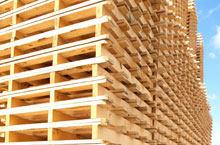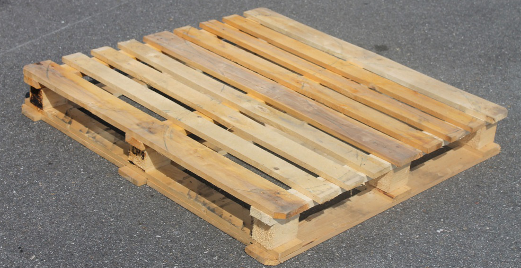Requirements for Shipping Wooden Pallet Packaging
14 Mar 2018
When exporting or importing wooden pallets, there are strict regulations to prevent the pallets, contents, padding or dunnage providing a means for pest species to move from country to country. Having your shipment seized by customs or other agencies while en route can be an expensive business.

As you can imagine, there are many regulations around the world, many of them put in place to deal with purely local problems or deal with temporary emergencies – like the Asian longhorn beetle in Portugal. Fortunately, however, the main body of requirements has been set out in “International Standards for Phytosanitary Measures” (ISPM15) by the International Plant Protection Convention (the IPPC).
Wooden packaging professionally manufactured in an EU member state will normally already comply with these regulations, but check with your packaging supplier that this is the case – not only for the pallets but for any additional padding or dunnage accompanying a shipment. It’s even more important to check when you’re importing wooden pallets from a non-EU state. In some cases pallets can be treated in transit, but someone will have to meet the cost (usually the importer in the first instance).
Compliance
The most reliable and universally accepted way of treating pallet timber is thorough debarking followed by a form of heat treatment or fumigation with methyl bromide. Once this has been professionally conducted, the pallet will be branded with a mark of compliance, often called “the wheat stamp”. Kiln-dried pallets will also carry a “KD” brand.
Although IPPC regulations allow European pallets to move relatively freely around the EU, bear in mind that there are a few exceptions, such as Portugal and also Ireland – north and south. Because the threats from pests change from time to time, so may the rules about importing and exporting wooden pallets.
Exceptions
Some kinds of chipboard, plywood, and paper products are not covered by ISPM15, but seeking expert advice about them is still important. Generally speaking, ISPM15 deals with wood materials thicker than 6mm. Wine barrels are also usually exempt (other manufacturing treatments will have already rendered them safe), and also certain types of wooden container such as cigar boxes (because standards have been set by other international agreements).
Exports
Although European standards like ISPM15 are widely respected around the world, if you’re exporting wooden pallets, remember that they will need to comply with the rules where they were manufactured and the rules of countries they are sent to or shipped through. If pallets have stopped anywhere for renovation or repair, they will need to comply with the regulations of that country too.
Check whether each and every country involved is a party to ISPM15 and whether any have additional measures in place. The Timber Packaging and Pallet Confederation (TIMCON) is a helpful source of information, as are national embassies and professional pallet supply companies like Associated Pallets.
Whether exporting or importing wooden pallets, be vigilant about any signs of infestation. It’s an offence not to notify the authorities about any potential tree pests, and there could be penalties if you neglect to do so.
4 Ways To Prevent Damage When Transporting Pallets
If you run a transportation company, it is likely that preventing damage when transporting pallets is a priority for you. After all, regularly replacing pallets can be fairly expensive, and broken pallets can damage the products that you are transporting.
Thankfully, it is entirely possible to prevent damage to your pallets – you just need to make sure that you are looking after the pallets properly. Here are four tips to help make sure you are moving pallets safely.

How to Prevent Damage to Your Pallets
Minimise Handling
Preventing damage when transporting pallets safely is possible if you consider how the pallets are treated before final delivery.
Some pallets that are used regularly can be handled up to ten times as they are loaded and collected for final delivery, which can weaken them and increase the chances of their becoming damaged.
You can avoid this by making sure that they are handled as infrequently as possible; consider shortening the packaging process, or reduce how many times the pallets are transported before they leave the warehouse.
Use High-Quality Pallets
If you use Grade A pallets with around one inch space between the lats, they are less likely to be damaged during transit.
This is because a wider space makes it easier for the pallets to bend so that the goods sink through, which can warp the pallet. It also means that the pallet could get caught in the forks, damaging it even further.
Check the Pallets Regularly
Employees should regularly check the bottom lats for signs of damage as they work, as this reduces the chances of one breaking with products on it.
They should also check that it is the right pallet for the goods being transported and that is has the correct label and stacking information for the goods it is transporting.
Finally, the employee should check that there is enough packaging around the products, as if the packaging breaks the pallet could become damaged.
Consider Your Options
Preventing damage when transporting pallets is very easy if you follow these tips. This can help to cut costs, as you won’t need to buy new pallets as frequently, and it also means that you are less likely to accidentally damage the products that you are transporting.


